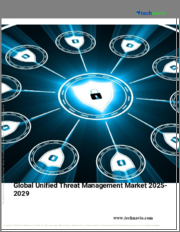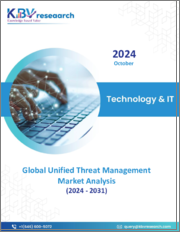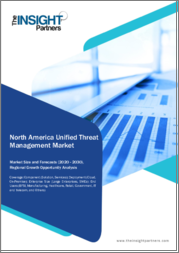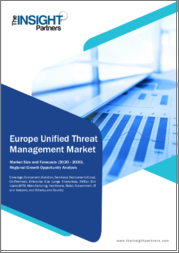
|
시장보고서
상품코드
1841630
통합 위협 관리 시장 : 세계 산업 규모, 점유율, 동향, 기회, 예측 - 경쟁별, 전개 방식별, 최종사용자별, 지역별, 경쟁별(2020-2030년)Unified Threat Management Market - Global Industry Size, Share, Trends, Opportunity, and Forecast, Segmented By Component, By Deployment Type, By End-User, By Region & Competition, 2020-2030F |
||||||
세계의 통합 위협 관리 시장 규모는 2024년에 56억 9,000만 달러로 평가되었으며, 예측 기간 동안 CAGR 11.53%로 2030년에는 110억 5,000만 달러에 달할 것으로 예측됩니다.
| 시장 개요 | |
|---|---|
| 예측 기간 | 2026-2030년 |
| 시장 규모 : 2024년 | 56억 9,000만 달러 |
| 시장 규모 : 2030년 | 110억 5,000만 달러 |
| CAGR : 2025-2030년 | 11.53% |
| 급성장 부문 | 클라우드 |
| 최대 시장 | 북미 |
통합 위협 관리 시장은 여러 사이버 보안 기능을 단일 플랫폼에 통합하여 다양한 위협으로부터 네트워크, 시스템, 데이터를 보호하는 통합 보안 솔루션 시장을 말합니다. 방화벽, 침입탐지, 안티바이러스, 컨텐츠 필터링 등 개별 도구에 의존하는 기존 보안 대책과 달리, 통합 위협 관리 시스템은 이러한 기능을 중앙집중식 솔루션으로 통합하여 종합적인 접근 방식을 제공합니다. 이 통합은 보안 관리를 간소화하고, 운영의 복잡성을 줄이며, 진화하는 사이버 위협에 보다 효과적으로 대응할 수 있도록 돕습니다. 통합 위협 관리 솔루션은 은행, 금융 서비스, 헬스케어, IT, 정부 기관, 소매, E-Commerce 등 다양한 산업의 중소기업부터 대기업까지 모든 규모의 기업에 대응할 수 있도록 설계되었습니다.
랜섬웨어, 피싱, 악성코드, 지능형지속위협 등 사이버 공격이 고도화되면서 기존의 단편적인 보안 대책으로는 효과가 떨어지고 있어 시장이 크게 성장하고 있습니다. 또한, 클라우드 컴퓨팅, 원격 근무, 디지털 전환의 도입이 증가함에 따라 조직의 공격 대상이 확대되고, 실시간 모니터링, 위협 인텔리전스, 자동화된 대응, 종합적인 컴플라이언스 관리를 제공하는 통합 보안 솔루션에 대한 수요가 증가하고 있습니다.에 대한 수요가 증가하고 있습니다. 또한, 특히 금융 서비스나 헬스케어와 같이 규제가 엄격한 분야에서 기밀 데이터를 보호하기 위해 강력한 사이버 보안 조치를 의무화하는 규제 요건도 시장을 촉진하고 있습니다.
또한, 위협 탐지, 예측 분석, 사고 대응 자동화를 강화하기 위해 인공지능과 머신러닝의 발전이 통합 위협 관리 플랫폼에 통합되어 그 효과와 도입이 더욱 확대되고 있습니다. 기업들은 비용 효율적이고, 확장 가능하며, 관리하기 쉬운 솔루션을 찾고 있습니다. 통합 위협 관리 플랫폼은 여러 포인트 제품의 필요성을 줄이고, 유지보수 및 운영 오버헤드를 최소화하여 이러한 솔루션을 제공합니다.
사이버 리스크에 대한 인식이 높아지고 지속적인 기술 혁신이 이루어짐에 따라 통합 위협 관리 시장은 향후 몇 년 동안 꾸준히 성장할 것으로 예상됩니다. 중요한 인프라를 보호하고, 비즈니스 연속성을 보장하며, 진화하는 사이버 위협으로부터 조직의 데이터를 보호할 수 있는 종합적이고 사전 예방적이며 적응력이 뛰어난 보안 솔루션에 대한 수요가 증가하고 있습니다.
시장 촉진요인
사이버 위협의 고도화로 종합적인 보안 솔루션에 대한 수요 증가
주요 시장 과제
높은 도입 비용과 운영 비용
주요 시장 동향
인공지능과 머신러닝의 통합
목차
제1장 개요
제2장 조사 방법
제3장 주요 요약
제4장 고객의 소리
제5장 세계의 통합 위협 관리 시장 전망
- 시장 규모 및 예측
- 금액별
- 시장 점유율과 예측
- 구성요소별(하드웨어, 소프트웨어, 서비스)
- 전개 방식별(온프레미스, 클라우드)
- 최종사용자별(은행, 금융 서비스, 보험, 정보기술 및 통신, 정부 및 방위, 헬스케어, 소매 및 E-Commerce, 기타)
- 지역별(북미, 유럽, 남미, 중동 및 아프리카, 아시아태평양)
- 기업별(2024)
- 시장 맵
제6장 북미의 통합 위협 관리 시장 전망
- 시장 규모 및 예측
- 시장 점유율과 예측
- 북미 : 국가별 분석
- 미국
- 캐나다
- 멕시코
제7장 유럽의 통합 위협 관리 시장 전망
- 시장 규모 및 예측
- 시장 점유율과 예측
- 유럽 : 국가별 분석
- 독일
- 프랑스
- 영국
- 이탈리아
- 스페인
제8장 아시아태평양의 통합 위협 관리 시장 전망
- 시장 규모 및 예측
- 시장 점유율과 예측
- 아시아태평양 : 국가별 분석
- 중국
- 인도
- 일본
- 한국
- 호주
제9장 중동 및 아프리카의 통합 위협 관리 시장 전망
- 시장 규모 및 예측
- 시장 점유율과 예측
- 중동 및 아프리카 : 국가별 분석
- 사우디아라비아
- 아랍에미리트
- 남아프리카공화국
제10장 남미의 통합 위협 관리 시장 전망
- 시장 규모 및 예측
- 시장 점유율과 예측
- 남미 : 국가별 분석
- 브라질
- 콜롬비아
- 아르헨티나
제11장 시장 역학
- 성장 촉진요인
- 과제
제12장 시장 동향과 발전
- 인수합병
- 제품 출시
- 최근 동향
제13장 기업 개요
- Cisco Systems, Inc
- Fortinet, Inc.
- Check Point Software Technologies Ltd.
- Sophos Group plc
- Juniper Networks, Inc.
- Barracuda Networks, Inc.
- Huawei Technologies Co., Ltd.
- WatchGuard Technologies, Inc.
- Hillstone Networks
- SonicWall Inc.
제14장 전략적 제안
제15장 조사 회사 소개 및 면책사항
KSM 25.10.24Global Unified Threat Management Market was valued at USD 5.69 billion in 2024 and is expected to reach USD 11.05 billion by 2030 with a CAGR of 11.53% during the forecast period.
| Market Overview | |
|---|---|
| Forecast Period | 2026-2030 |
| Market Size 2024 | USD 5.69 Billion |
| Market Size 2030 | USD 11.05 Billion |
| CAGR 2025-2030 | 11.53% |
| Fastest Growing Segment | Cloud |
| Largest Market | North America |
The Unified Threat Management Market refers to the market for integrated security solutions that consolidate multiple cybersecurity functions into a single platform to protect networks, systems, and data from a wide range of threats. Unlike traditional security measures that rely on separate tools for firewalls, intrusion detection, antivirus, and content filtering, unified threat management systems provide a comprehensive approach, combining these functions into a centralized solution. This integration simplifies security management, reduces operational complexity, and allows organizations to respond more effectively to evolving cyber threats. Unified threat management solutions are designed to cater to enterprises of all sizes, from small and medium-sized businesses to large corporations, across various industries including banking, financial services, healthcare, information technology, government, retail, and e-commerce.
The market is witnessing substantial growth due to the increasing sophistication of cyberattacks, including ransomware, phishing, malware, and advanced persistent threats, which have made traditional, fragmented security measures less effective. Furthermore, the rising adoption of cloud computing, remote work, and digital transformation initiatives has expanded organizational attack surfaces, driving demand for integrated security solutions that offer real-time monitoring, threat intelligence, automated response, and comprehensive compliance management. The market is also being fueled by regulatory requirements that mandate robust cybersecurity measures to protect sensitive data, particularly in highly regulated sectors such as financial services and healthcare.
Additionally, advancements in artificial intelligence and machine learning are being incorporated into unified threat management platforms to enhance threat detection, predictive analytics, and automated incident response, further increasing their effectiveness and adoption. Organizations are increasingly seeking cost-efficient, scalable, and easy-to-manage solutions, which unified threat management platforms provide by reducing the need for multiple point products and minimizing maintenance and operational overhead.
With growing awareness about cyber risks and continuous technological innovation, the Unified Threat Management Market is expected to rise steadily in the coming years, driven by increasing demand for holistic, proactive, and adaptive security solutions that can safeguard critical infrastructure, ensure business continuity, and protect organizational data against the evolving landscape of cyber threats.
Key Market Drivers
Escalating Sophistication of Cyber Threats Driving Demand for Comprehensive Security Solutions
The Unified Threat Management market is experiencing significant growth due to the increasing sophistication and frequency of cyber threats, which are compelling organizations to adopt integrated security platforms that streamline protection against diverse attack vectors. As cybercriminals leverage advanced techniques such as ransomware, zero-day exploits, and AI-driven phishing campaigns, businesses face mounting pressure to safeguard their digital assets comprehensively. Traditional standalone security tools, like firewalls or antivirus software, are often insufficient to address multifaceted threats that exploit vulnerabilities across networks, endpoints, and cloud environments.
Unified Threat Management systems integrate multiple security functions, including firewall, intrusion detection and prevention, antivirus, VPN, and content filtering, into a single platform, offering a cohesive defense mechanism. This consolidation reduces complexity, enhances visibility, and enables real-time threat correlation, allowing organizations to respond swiftly to emerging risks. The rise of remote work and the proliferation of IoT devices further amplify the attack surface, making Unified Threat Management solutions indispensable for businesses seeking to protect distributed networks. For instance, the integration of AI-powered analytics within these platforms enables proactive threat detection by analyzing patterns and anomalies across vast datasets.
Additionally, regulatory pressures and the financial impact of data breaches drive enterprises to invest in robust security frameworks that ensure compliance and mitigate risks. The ability of Unified Threat Management systems to deliver centralized management and automated updates aligns with the needs of organizations aiming to stay ahead of evolving threats while maintaining operational efficiency. As cyber threats continue to evolve in complexity, the demand for Unified Threat Management solutions is expected to surge, particularly among enterprises prioritizing holistic security strategies over fragmented, point-solution approaches.
A 2023 report from the U.S. Department of Homeland Security noted a 20% year-over-year increase in cybercrime incidents, with over 76,000 cybercrime reports recorded in 2022 alone. This surge underscores the growing complexity of threats, with ransomware attacks rising by 15% and phishing attempts increasing by 25% compared to the previous year, highlighting the urgent need for integrated Unified Threat Management solutions to address multifaceted cyber risks effectively.
Key Market Challenges
High Implementation and Operational Costs
One of the primary challenges faced by organizations in the Unified Threat Management Market is the high cost associated with implementing and operating comprehensive security solutions. Deploying a unified threat management system often requires significant capital expenditure for purchasing hardware, licensing software, and integrating the solution into existing IT infrastructure. Beyond the initial investment, organizations must allocate substantial operational budgets for ongoing maintenance, updates, and system monitoring. Small and medium-sized enterprises are particularly affected, as the financial burden of implementing advanced security solutions may exceed their budgetary constraints, limiting their ability to adopt full-scale unified threat management systems.
Furthermore, the total cost of ownership is often compounded by the need for specialized personnel to manage and optimize these systems, as well as training existing staff to effectively utilize advanced features such as intrusion detection, content filtering, and automated threat response. The financial implications are further exacerbated by the rapid evolution of cyber threats, which necessitates frequent upgrades and additions to security modules to maintain protection effectiveness. For large enterprises, although financial resources are less of a constraint, the integration of unified threat management systems into complex, multi-layered IT environments can be a costly and time-consuming process.
Legacy systems and heterogeneous network architectures often require extensive customization and compatibility testing, leading to delays in deployment and increased expenses. Additionally, regulatory compliance obligations in sectors such as banking, healthcare, and government impose further cost pressures, as organizations must ensure that their unified threat management platforms meet stringent data security standards and reporting requirements.
These high implementation and operational costs act as a barrier to market adoption, particularly in emerging regions where IT budgets are limited. Solution providers need to address this challenge by offering scalable, modular, and cost-efficient solutions that provide flexibility for organizations to implement essential security functions first and expand capabilities over time, thereby reducing the upfront financial burden and facilitating broader market penetration.
Key Market Trends
Integration of Artificial Intelligence and Machine Learning
The integration of Artificial Intelligence (AI) and Machine Learning (ML) into Unified Threat Management solutions is revolutionizing the cybersecurity landscape. These technologies enable systems to analyze vast amounts of data in real-time, identifying patterns and anomalies that may indicate potential threats. AI and ML enhance threat detection capabilities, allowing for proactive identification of vulnerabilities and swift response to emerging threats. By automating routine tasks and providing predictive analytics, these technologies reduce the workload on security teams and improve overall efficiency. As cyber threats become more sophisticated, the demand for AI and ML-driven Unified Threat Management solutions is expected to grow, offering organizations advanced tools to safeguard their digital assets.
Key Market Players
- Cisco Systems, Inc.
- Fortinet, Inc.
- Check Point Software Technologies Ltd.
- Sophos Group plc
- Juniper Networks, Inc.
- Barracuda Networks, Inc.
- Huawei Technologies Co., Ltd.
- WatchGuard Technologies, Inc.
- Hillstone Networks
- SonicWall Inc.
Report Scope:
In this report, the Global Unified Threat Management Market has been segmented into the following categories, in addition to the industry trends which have also been detailed below:
Unified Threat Management Market, By Component:
- Hardware
- Software
- Services
Unified Threat Management Market, By Deployment Type:
- On-Premises
- Cloud
Unified Threat Management Market, By End-User:
- Banking, Financial Services, and Insurance
- Information Technology and Telecommunications
- Government and Defense
- Healthcare
- Retail and E-Commerce
- Others
Unified Threat Management Market, By Region:
- North America
- United States
- Canada
- Mexico
- Europe
- Germany
- France
- United Kingdom
- Italy
- Spain
- South America
- Brazil
- Argentina
- Colombia
- Asia-Pacific
- China
- India
- Japan
- South Korea
- Australia
- Middle East & Africa
- Saudi Arabia
- UAE
- South Africa
Competitive Landscape
Company Profiles: Detailed analysis of the major companies present in the Global Unified Threat Management Market.
Available Customizations:
Global Unified Threat Management Market report with the given market data, TechSci Research offers customizations according to a company's specific needs. The following customization options are available for the report:
Company Information
- Detailed analysis and profiling of additional market players (up to five).
Table of Contents
1. Product Overview
- 1.1. Market Definition
- 1.2. Scope of the Market
- 1.2.1. Markets Covered
- 1.2.2. Years Considered for Study
- 1.2.3. Key Market Segmentations
2. Research Methodology
- 2.1. Objective of the Study
- 2.2. Baseline Methodology
- 2.3. Key Industry Partners
- 2.4. Major Association and Secondary Sources
- 2.5. Forecasting Methodology
- 2.6. Data Triangulation & Validation
- 2.7. Assumptions and Limitations
3. Executive Summary
- 3.1. Overview of the Market
- 3.2. Overview of Key Market Segmentations
- 3.3. Overview of Key Market Players
- 3.4. Overview of Key Regions/Countries
- 3.5. Overview of Market Drivers, Challenges, and Trends
4. Voice of Customer
5. Global Unified Threat Management Market Outlook
- 5.1. Market Size & Forecast
- 5.1.1. By Value
- 5.2. Market Share & Forecast
- 5.2.1. By Component (Hardware, Software, Services)
- 5.2.2. By Deployment Type (On-Premises, Cloud)
- 5.2.3. By End-User (Banking, Financial Services, and Insurance, Information Technology and Telecommunications, Government and Defense, Healthcare, Retail and E-Commerce, Others)
- 5.2.4. By Region (North America, Europe, South America, Middle East & Africa, Asia Pacific)
- 5.3. By Company (2024)
- 5.4. Market Map
6. North America Unified Threat Management Market Outlook
- 6.1. Market Size & Forecast
- 6.1.1. By Value
- 6.2. Market Share & Forecast
- 6.2.1. By Component
- 6.2.2. By Deployment Type
- 6.2.3. By End-User
- 6.2.4. By Country
- 6.3. North America: Country Analysis
- 6.3.1. United States Unified Threat Management Market Outlook
- 6.3.1.1. Market Size & Forecast
- 6.3.1.1.1. By Value
- 6.3.1.2. Market Share & Forecast
- 6.3.1.2.1. By Component
- 6.3.1.2.2. By Deployment Type
- 6.3.1.2.3. By End-User
- 6.3.1.1. Market Size & Forecast
- 6.3.2. Canada Unified Threat Management Market Outlook
- 6.3.2.1. Market Size & Forecast
- 6.3.2.1.1. By Value
- 6.3.2.2. Market Share & Forecast
- 6.3.2.2.1. By Component
- 6.3.2.2.2. By Deployment Type
- 6.3.2.2.3. By End-User
- 6.3.2.1. Market Size & Forecast
- 6.3.3. Mexico Unified Threat Management Market Outlook
- 6.3.3.1. Market Size & Forecast
- 6.3.3.1.1. By Value
- 6.3.3.2. Market Share & Forecast
- 6.3.3.2.1. By Component
- 6.3.3.2.2. By Deployment Type
- 6.3.3.2.3. By End-User
- 6.3.3.1. Market Size & Forecast
- 6.3.1. United States Unified Threat Management Market Outlook
7. Europe Unified Threat Management Market Outlook
- 7.1. Market Size & Forecast
- 7.1.1. By Value
- 7.2. Market Share & Forecast
- 7.2.1. By Component
- 7.2.2. By Deployment Type
- 7.2.3. By End-User
- 7.2.4. By Country
- 7.3. Europe: Country Analysis
- 7.3.1. Germany Unified Threat Management Market Outlook
- 7.3.1.1. Market Size & Forecast
- 7.3.1.1.1. By Value
- 7.3.1.2. Market Share & Forecast
- 7.3.1.2.1. By Component
- 7.3.1.2.2. By Deployment Type
- 7.3.1.2.3. By End-User
- 7.3.1.1. Market Size & Forecast
- 7.3.2. France Unified Threat Management Market Outlook
- 7.3.2.1. Market Size & Forecast
- 7.3.2.1.1. By Value
- 7.3.2.2. Market Share & Forecast
- 7.3.2.2.1. By Component
- 7.3.2.2.2. By Deployment Type
- 7.3.2.2.3. By End-User
- 7.3.2.1. Market Size & Forecast
- 7.3.3. United Kingdom Unified Threat Management Market Outlook
- 7.3.3.1. Market Size & Forecast
- 7.3.3.1.1. By Value
- 7.3.3.2. Market Share & Forecast
- 7.3.3.2.1. By Component
- 7.3.3.2.2. By Deployment Type
- 7.3.3.2.3. By End-User
- 7.3.3.1. Market Size & Forecast
- 7.3.4. Italy Unified Threat Management Market Outlook
- 7.3.4.1. Market Size & Forecast
- 7.3.4.1.1. By Value
- 7.3.4.2. Market Share & Forecast
- 7.3.4.2.1. By Component
- 7.3.4.2.2. By Deployment Type
- 7.3.4.2.3. By End-User
- 7.3.4.1. Market Size & Forecast
- 7.3.5. Spain Unified Threat Management Market Outlook
- 7.3.5.1. Market Size & Forecast
- 7.3.5.1.1. By Value
- 7.3.5.2. Market Share & Forecast
- 7.3.5.2.1. By Component
- 7.3.5.2.2. By Deployment Type
- 7.3.5.2.3. By End-User
- 7.3.5.1. Market Size & Forecast
- 7.3.1. Germany Unified Threat Management Market Outlook
8. Asia Pacific Unified Threat Management Market Outlook
- 8.1. Market Size & Forecast
- 8.1.1. By Value
- 8.2. Market Share & Forecast
- 8.2.1. By Component
- 8.2.2. By Deployment Type
- 8.2.3. By End-User
- 8.2.4. By Country
- 8.3. Asia Pacific: Country Analysis
- 8.3.1. China Unified Threat Management Market Outlook
- 8.3.1.1. Market Size & Forecast
- 8.3.1.1.1. By Value
- 8.3.1.2. Market Share & Forecast
- 8.3.1.2.1. By Component
- 8.3.1.2.2. By Deployment Type
- 8.3.1.2.3. By End-User
- 8.3.1.1. Market Size & Forecast
- 8.3.2. India Unified Threat Management Market Outlook
- 8.3.2.1. Market Size & Forecast
- 8.3.2.1.1. By Value
- 8.3.2.2. Market Share & Forecast
- 8.3.2.2.1. By Component
- 8.3.2.2.2. By Deployment Type
- 8.3.2.2.3. By End-User
- 8.3.2.1. Market Size & Forecast
- 8.3.3. Japan Unified Threat Management Market Outlook
- 8.3.3.1. Market Size & Forecast
- 8.3.3.1.1. By Value
- 8.3.3.2. Market Share & Forecast
- 8.3.3.2.1. By Component
- 8.3.3.2.2. By Deployment Type
- 8.3.3.2.3. By End-User
- 8.3.3.1. Market Size & Forecast
- 8.3.4. South Korea Unified Threat Management Market Outlook
- 8.3.4.1. Market Size & Forecast
- 8.3.4.1.1. By Value
- 8.3.4.2. Market Share & Forecast
- 8.3.4.2.1. By Component
- 8.3.4.2.2. By Deployment Type
- 8.3.4.2.3. By End-User
- 8.3.4.1. Market Size & Forecast
- 8.3.5. Australia Unified Threat Management Market Outlook
- 8.3.5.1. Market Size & Forecast
- 8.3.5.1.1. By Value
- 8.3.5.2. Market Share & Forecast
- 8.3.5.2.1. By Component
- 8.3.5.2.2. By Deployment Type
- 8.3.5.2.3. By End-User
- 8.3.5.1. Market Size & Forecast
- 8.3.1. China Unified Threat Management Market Outlook
9. Middle East & Africa Unified Threat Management Market Outlook
- 9.1. Market Size & Forecast
- 9.1.1. By Value
- 9.2. Market Share & Forecast
- 9.2.1. By Component
- 9.2.2. By Deployment Type
- 9.2.3. By End-User
- 9.2.4. By Country
- 9.3. Middle East & Africa: Country Analysis
- 9.3.1. Saudi Arabia Unified Threat Management Market Outlook
- 9.3.1.1. Market Size & Forecast
- 9.3.1.1.1. By Value
- 9.3.1.2. Market Share & Forecast
- 9.3.1.2.1. By Component
- 9.3.1.2.2. By Deployment Type
- 9.3.1.2.3. By End-User
- 9.3.1.1. Market Size & Forecast
- 9.3.2. UAE Unified Threat Management Market Outlook
- 9.3.2.1. Market Size & Forecast
- 9.3.2.1.1. By Value
- 9.3.2.2. Market Share & Forecast
- 9.3.2.2.1. By Component
- 9.3.2.2.2. By Deployment Type
- 9.3.2.2.3. By End-User
- 9.3.2.1. Market Size & Forecast
- 9.3.3. South Africa Unified Threat Management Market Outlook
- 9.3.3.1. Market Size & Forecast
- 9.3.3.1.1. By Value
- 9.3.3.2. Market Share & Forecast
- 9.3.3.2.1. By Component
- 9.3.3.2.2. By Deployment Type
- 9.3.3.2.3. By End-User
- 9.3.3.1. Market Size & Forecast
- 9.3.1. Saudi Arabia Unified Threat Management Market Outlook
10. South America Unified Threat Management Market Outlook
- 10.1. Market Size & Forecast
- 10.1.1. By Value
- 10.2. Market Share & Forecast
- 10.2.1. By Component
- 10.2.2. By Deployment Type
- 10.2.3. By End-User
- 10.2.4. By Country
- 10.3. South America: Country Analysis
- 10.3.1. Brazil Unified Threat Management Market Outlook
- 10.3.1.1. Market Size & Forecast
- 10.3.1.1.1. By Value
- 10.3.1.2. Market Share & Forecast
- 10.3.1.2.1. By Component
- 10.3.1.2.2. By Deployment Type
- 10.3.1.2.3. By End-User
- 10.3.1.1. Market Size & Forecast
- 10.3.2. Colombia Unified Threat Management Market Outlook
- 10.3.2.1. Market Size & Forecast
- 10.3.2.1.1. By Value
- 10.3.2.2. Market Share & Forecast
- 10.3.2.2.1. By Component
- 10.3.2.2.2. By Deployment Type
- 10.3.2.2.3. By End-User
- 10.3.2.1. Market Size & Forecast
- 10.3.3. Argentina Unified Threat Management Market Outlook
- 10.3.3.1. Market Size & Forecast
- 10.3.3.1.1. By Value
- 10.3.3.2. Market Share & Forecast
- 10.3.3.2.1. By Component
- 10.3.3.2.2. By Deployment Type
- 10.3.3.2.3. By End-User
- 10.3.3.1. Market Size & Forecast
- 10.3.1. Brazil Unified Threat Management Market Outlook
11. Market Dynamics
- 11.1. Drivers
- 11.2. Challenges
12. Market Trends and Developments
- 12.1. Merger & Acquisition (If Any)
- 12.2. Product Launches (If Any)
- 12.3. Recent Developments
13. Company Profiles
- 13.1. Cisco Systems, Inc
- 13.1.1. Business Overview
- 13.1.2. Key Revenue and Financials
- 13.1.3. Recent Developments
- 13.1.4. Key Personnel
- 13.1.5. Key Product/Services Offered
- 13.2. Fortinet, Inc.
- 13.3. Check Point Software Technologies Ltd.
- 13.4. Sophos Group plc
- 13.5. Juniper Networks, Inc.
- 13.6. Barracuda Networks, Inc.
- 13.7. Huawei Technologies Co., Ltd.
- 13.8. WatchGuard Technologies, Inc.
- 13.9. Hillstone Networks
- 13.10. SonicWall Inc.
14. Strategic Recommendations
15. About Us & Disclaimer
(주말 및 공휴일 제외)
















